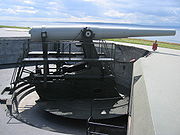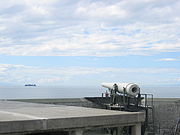
Fort Casey
Encyclopedia


Whidbey Island
Whidbey Island is one of nine islands located in Island County, Washington, in the United States. Whidbey is located about north of Seattle, and lies between the Olympic Peninsula and the I-5 corridor of western Washington...
in Washington state. Admiralty Inlet
Admiralty Inlet
Admiralty Inlet is a strait in the U.S. state of Washington connecting the eastern end of the Strait of Juan de Fuca to Puget Sound. It lies between Whidbey Island and the northeastern part of the Olympic Peninsula....
was considered so strategic to the defense of Puget Sound
Puget Sound
Puget Sound is a sound in the U.S. state of Washington. It is a complex estuarine system of interconnected marine waterways and basins, with one major and one minor connection to the Strait of Juan de Fuca and the Pacific Ocean — Admiralty Inlet being the major connection and...
in the 1890s that three forts, Fort Casey on Whidbey Island, Fort Flagler on Marrowstone Island, and Fort Worden
Fort Worden
Fort Worden and accompanying Fort Worden State Park are located in Port Townsend, along Admiralty Inlet in Washington. It is situated on 433 acres originally built as a United States Army installation for the protection of Puget Sound. Fort Worden was named after U.S...
at Port Townsend, were built at the entrance with huge guns creating a "Triangle of Fire." This military strategy was built on the theory that the three fortresses would thwart any invasion attempt by sea. Fort Casey is now a 467 acres (1.9 km²) marine camping park. The Admiralty Head Lighthouse
Admiralty Head Lighthouse
The Admiralty Head Light is a lighthouse located in Fort Casey State Park near Coupeville on Whidbey Island, Washington.Admiralty Head is the east entrance point of Admiralty Inlet and the southeast extremity of a succession of light bare bluffs which extend north of Point Partridge, where they...
is located in the state park.
History
Construction on Fort Casey was started in 1897. In 1901, her big guns on disappearing carriagesDisappearing gun
A disappearing gun is a type of heavy artillery for which the gun carriage enabled the gun to rotate backwards and down into a pit protected by a wall or a bunker after it was fired...
, which could be raised out of their protective emplacements so that the guns were exposed only long enough to fire, became active. However, the fort's ammunition batteries became obsolete almost as soon as their construction was completed. The invention of the airplane in 1903, and the subsequent development of military aircraft made the fort vulnerable to air attack. In addition, the development of battleships designed with increasingly accurate weaponry transformed the static strategies of the nineteenth century into the more mobile attack systems of the twentieth century. Most of Fort Casey's guns and mortars were removed and sent to Europe and the Pacific during World War II
World War II
World War II, or the Second World War , was a global conflict lasting from 1939 to 1945, involving most of the world's nations—including all of the great powers—eventually forming two opposing military alliances: the Allies and the Axis...
, where they were mounted on railcars to serve as mobile heavy artillery.
In 1935, the Coast Artillery
Coastal artillery
Coastal artillery is the branch of armed forces concerned with operating anti-ship artillery or fixed gun batteries in coastal fortifications....
withdrew the station's battery assignments and placed it on inactive status. As World War II
World War II
World War II, or the Second World War , was a global conflict lasting from 1939 to 1945, involving most of the world's nations—including all of the great powers—eventually forming two opposing military alliances: the Allies and the Axis...
approached, military officials reactivated Fort Casey after making physical improvements to the aging frame-plaster construction.
Two of the fort's 10-inch (25-cm) seacoast artillery guns on their carriages were salvaged in the mid-1960s from their final active duty location at Fort Wint
Fort Wint
Fort Wint was part of the harbor defenses of Manila and Subic Bays built by the Philippine Department of the United States Army between 1907 and 1920 in response to recommendations of the Taft Board prior to the non-fortification clause of the Washington Naval Treaty...
on the U. S. Naval Base Subic Bay. The guns showed visible shrapnel scarring from the effects of the Japanese bombings in the Philippines at the opening of World War II. Two 3-inch (76-mm) rapid-fire guns from Fort Wint are also mounted at Fort Casey.

